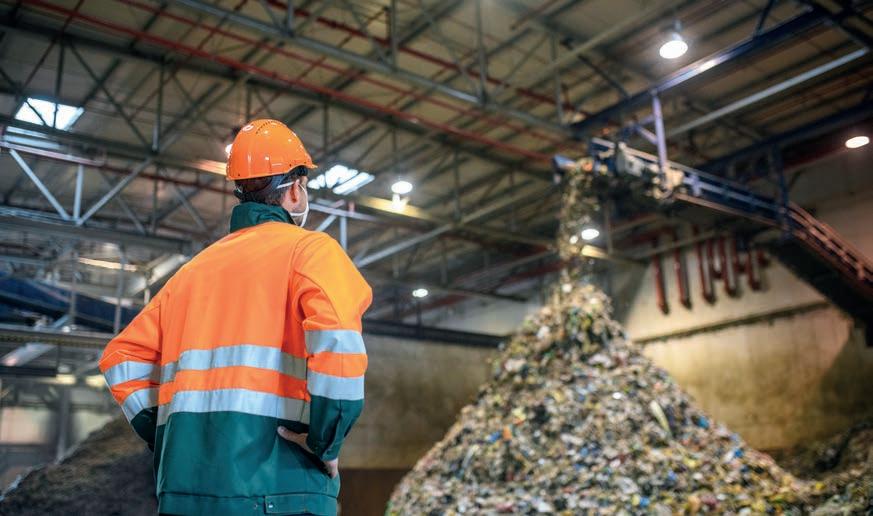
8 minute read
The golden thread
BUILDING SAFETY
Finding the golden thread
The UK’s building safety bill requires a ‘golden thread’ of information - with major implications for facilities managers, says Paul McDevitt
The UK’s building safety bill, expected to be enacted in 2023, will ensure accountability for everyone involved in the life cycle of high-rise residential buildings over six storeys or 18 metres. It requires a ‘golden thread’ of information to detail how a building was designed, built and maintained throughout its lifetime, recording decisions and creating a trail of accountability to support building safety.
These regulatory changes are likely to have financial and practical consequences for the residential facilities management sector. For example, when residents move into a building it will need to be registered with the building safety regulator and an application made for a building assurance certificate.
A designated ‘accountable person’ must conduct and maintain a risk assessment for the building, and a building safety manager will oversee this day to day.
Building inspectors who sign buildings off as safe will have to follow the new rules and register with the regulator. Duty holders with statutory responsibilities will be accountable for managing all risks across the building’s life cycle.
Maintaining the thread
The UK Government’s Ministry of Housing, Communities & Local Government has said the golden thread must: 1. Be accurate and trusted; 2. Make residents feel secure due to its accuracy and trustworthiness; 3. Support culture change and enable collaborative working; 4. Provide a single point of truth by collating all information; 5. Protect personal information and maintain building security; 6. Record any changes, who made them and when to improve accountability; 7. Be easily understood and simple to access; 8. Be easily handed over and maintained; and 9. Relevant and proportionate.
The golden thread will create safer outcomes compared with traditional H&S policies because it covers the full life cycle of the building and requires an integrated approach. It ensures that those responsible for higher-risk residential buildings inspect the competence levels of the people working on their buildings.
In addition to organisations’ legal compliance commitments, the golden thread goes further by demanding an annual building safety case for each building in scope and satisfies the new building safety regulations.
Challenges for FM
● Checking and reporting on the competence of those designing, constructing, repairing and operating buildings; ● Costs related to aggregating golden thread information, particularly for organisations responsible for multiple tower blocks; and ● Legacy IT systems may create gaps in essential data and cause delays as information must be digitised, which may require the use of drones and digital scanning to create 3D scans of existing buildings – all of which requires specific expertise.
Potential solutions A building asset portal can be used to gather, consolidate, store, manage and provide 24/7 availability of data with controlled access. Efficient data and asset management will identify information gaps to make informed decisions.
PAUL Data management MCDEVITTm is managing director at TÜV software and data management
SÜD Building techniques –
Advisory including fully Service, a data integrated BIM management and analytics models and digital business twins – can create easily navigable and secure dashboards for relevant stakeholders for real-time review.
It may not be necessary to seek out new proprietary software either, depending on the quality of existing systems and processes. However, legacy systems may not accurately collate golden thread information. And more systems could mean more gaps in data.
Documents and information should be stored and kept according to statutory guidance (yet to be issued). This will give building control authorities or other prescribed persons power to request documents and information be shared with them and others.
The building safety bill’s new requirements must be complied with in a tight timescale over the next two years and failure to do so could lead to significant financial penalties and or imprisonment. However, in the long term, improving accountability for those involved in a building’s entire life cycle will raise the bar for safety, quality and sustainability, ultimately reducing risk for building owners, managers and occupiers.
PHOTOGRAPHY: ISTOCK
Recycling and resource management support decarbonisation. But many FMs fail to see the link – perhaps due to a lack of knowledge about the waste journey or the available waste management options .
Despite increased efforts to ‘reduce, reuse, recycle’, around 50 per cent of commercial waste goes to landfill or incineration and it’s this portion – if managed strategically – that has the power to transform organisations’ green credentials.
Forgotten waste is how we refer to the mixed residual waste that can’t be segregated or sorted for recycling because it contains contamination such as an organic fraction. This waste is sent to landfill or incineration.
By turning to biotechnology, organisations can reduce the mass and volume of the residual waste stream by 50 per cent and up to 80 per cent respectively on site, which means considerably less waste goes to landfill or Energy from Waste plants, there are fewer collections to pay for and less road-related carbon.
How it works
Waste is digested using unique blends of bacteria inside enclosed aerobic reactors, which are installed on-site. This decentralised approach to waste management not only cuts the cost incurred for collection, transportation and disposal, but frees up waste-handling resources and encourages businesses to take more responsibility for their own waste.
The machines operate almost autonomously, requiring little infrastructure – just a concrete base and electrical outlet – and minimal interaction from FMs or recycling teams.
The process is simple: a wheelie bin is placed onto a bin lift and the machine takes over, lifting and emptying the waste into a hopper, which, in turn, feeds a shredder. Then the magic happens. Biotech additives are introduced, and the organic waste is digested. The bi-products of the aerobic digestion process are carbon dioxide and water vapour, and all that’s left behind is ‘floc’ – the inorganic fraction, which has a number of potential uses as an solid recovered fuel (SRF). Licensing and costs
Getting started
During the commissioning stage, an organisation’s waste is analysed to determine the level of treatment required. The machine’s settings are set and FMs are given full training. Little input is required on a day-to-day basis as the built-in software only permits access to certain features and alerts users to any issues, mitigating the risk of human error. A personalised customer support programme, delivered on and off-line, also helps maximise the benefits of the machine at a specific site.
STEPHEN WISE is chief strategic development officer at Advetec This type of waste treatment requires a bespoke licence from the Environment Agency, but as soon as a licence application is made, machines can operate and FMs can begin reaping the
WASTE MANAGEMENT
Biotech benefi ts
Biotechnology can help FMs bett er manage waste to help reach sustainability goals, says Dr Stephen Wise
rewards. A preparation pack is available with the information required to progress an application. Plus the wheels are already in motion with regulators to switch to a standard licence.
For businesses and waste producers, there’s a compelling financial benefit to taking an innovative approach to waste handling. The current (Dec 2021) cost to send waste to conventional mass burn incineration at an EfW plant is approximately £120 to £130 per tonne, whereas sending it as an SRF for either blending with other materials or for direct use, reduces it by 40 per cent.
The pressure for FMs to not just think but act greener is increasing. However, change does not have to be complex. Biotechnology simplifies waste management. Combined with prioritising waste education and embracing the technologies and green solutions available, FMs have the power to help organisations achieve their ESG goals and become positive change activists.

1
DILAPIDATIONS – THE OVERLOOKED CONTRACT CLAUSE
Heed the old adage ‘dilapidations negotiations begin before you sign the contract’, says Matt Blaydon, partner at property consultant Matt hews & Goodman
Key takeaways:
● Moving your workplace to a different property is exciting but costly. An oft en overlooked ‘exit cost’ is dilapidations: a claim made by a landlord to ensure the tenant complies with their lease covenants to repair, redecorate and reinstate the premises. ● Be sure you understand any clauses related to dilapidations in the lease – especially at the heads of terms stage – well before you sign the contract. This will reduce your financial risk exposure. ● Consider your ‘dilapidations exposure’ well before the end of the lease, as repairs can usually be undertaken more cost-effectively by you than by the landlord. Read the full article at tinyurl.com/ Fac010222dilapidations
2
PROPERTY OPTIMISATION PRIORITIES
A challenge for facilities service providers is helping their clients meet oft en contradictory and competing goals, says Matt Chapman, chief marketing & development officer (UK & Ireland) at Atalian Servest
The Know How learning continues at facilitatemagazine.com. Below is a summary of the key takeaways from a selection of our onlineonly articles
Key takeaways:
● Clients face four major challenges: reducing operating costs, meeting net zero commitments, adjusting to the implications of Covid-19, and using buildings to help att ract and retain key talent. ● FMs must work smarter to find synergies between oft en conflicting goals such as through enhanced collaboration. Without this working relationship, suggestions to clients won’t be properly actioned. ● Service contracts need to be extended to deliver on long-term goals. Many net-zero goals, for example, look towards 2030 – nine years from now. Companies need a nine-year strategy, not two, four or five-year strategies.
Read the full article at tinyurl.com/ Fac010222propops
3
FIRE SAFETY: SOCIAL HOUSING LANDLORDS
Only buildings over 18m tall are eligible for support from the government’s Building Safety Fund, says Basil Jackson, MD at Vemco Consulting
Key takeaways:
● New advice says buildings under 18m don’t require an external wall assessment of cladding, façades and balconies. A relief for leaseholders – but many of these buildings remain unsafe. ● The government should give advice that outlines a valid way to improve the quality of buildings below 18m. ● Some housing associations have highlighted how fire safety work comes at the expense of other work landlords must carry out, including decarbonisation.
Read the full article at tinyurl.com/ Fac010222-social












